


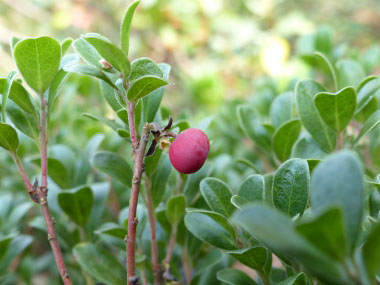
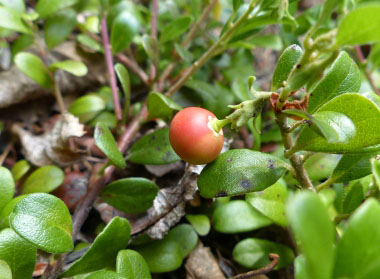
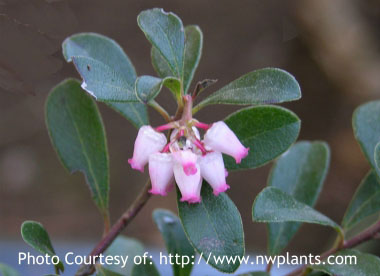
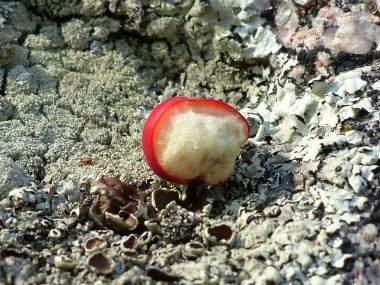
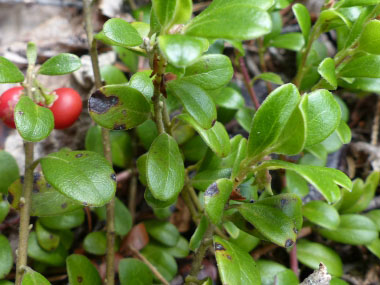
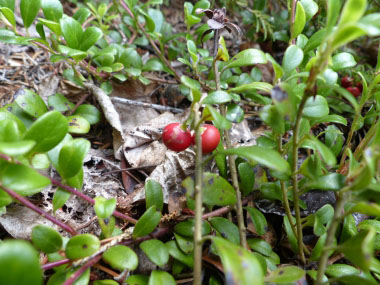


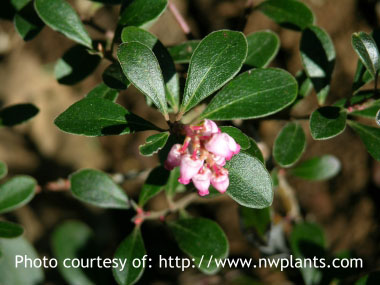
To support our efforts please browse our store (books with health benefits, etc.).
Bearberry is known as Kinnikinnick which is pronounced KINNY-kin-ICK, or Kinn-ICK-innick, and is belived to come from the Alonquin meaning “smoking mixture.” Bearberry comes from its genus Arctostaphylos, from the Greek word for bear – Arktos and staphylos – a bunch of grapes, which its berries resemble. The species name of uva-ursi is apparently from the Latin uva (grape) and ursus (bear). Bearberries look like lingonberries (Vaccinium vitis-idaea), but they are not related. Lingonberry’s stems are erect: bearberry is limply creeping and only the tips of the stems are slightly ascending. Bearberry’s leaves are narrower and gradually tapering towards the base.
Distinguishing Features
Bearberry is a trailing, evergreen shrub with paddle-shaped leaves on flexible branches. The thick, leathery leaves are rolled under at the edges. They are yellow-green in spring, dark-green in summer, and reddish-purple in the fall. Leaves remain on the bush year-round. This low-growing shrub slowly spreads to form dense mats. This ground-trailing shrub has the papery, reddish, exfoliating bark typical of woody plants in northern climates. It is frequently seen as a ground cover in sandy areas.
Flowers
Small clusters of white-pink flowers hang down from the tips of branches. Their five petals are fused together, giving them an upside-down frilly-vase look. Blooms can appear any time from April to July. Fruit develops at the end of summer. Flowers produce red, shiny berries that are rather tasteless.
 Fields
of Nutrition has medicinal benefits and vitamin/mineral content of Bearberry.
Fields
of Nutrition has medicinal benefits and vitamin/mineral content of Bearberry.
Leaves
Leaves are alternate, short-stalked, and they overwinter. Leaf blades are obovate, 1 to 3 cm (0.4 to 1.2”) long, leathery, glabrous, underside is green, and they have a clear net-like leaf venation.
Height
Bearberry typically grows to 15 to 20 centimetres (6 to 8”) tall. Its older stems tend to be reddish-brown to grey, fairly smooth and peeling, whereas new stems can be redder and covered with smooth hair.
Habitat
Bearberries typically grow along sandy and rocky areas including shorelines, slopes, ridges, hilltops and in coniferous and mixed woods. This hardy plant grows at various levels from sea level to sub-alpine. They also grow in dry forest heaths, sand and gravel embankments. It is the only Arctostaphylos species to occur outside of North America, ranging across northern Europe and Asia and it is found in the mountains of Guatemala.
Edible Parts
The bright red berries are edible and young leaves are often used as tea.
Other Name
Kinnikinnick.
Similar Plants
Lingonberries.
Winter Survival Food Handbook

PDF Plant Magazines
Types of Wild Food
Geographic Zones Seasons
Disclaimer
EdibleWildFood.com is informational in nature. While we strive to be 100% accurate, it is solely up to the reader to ensure proper plant identification. Some wild plants are poisonous or can have serious adverse health effects.
We are not health professionals, medical doctors, nor are we nutritionists. It is up to the reader to verify nutritional information and health benefits with qualified professionals for all edible plants listed in this web site. Please click here for more information.
Why Edible Wild Food?
- Food costs are rising
- Free, wild food is readily abundant
- Wild food adds nutrition to your diet
- Wild food can help treat various medical conditions





